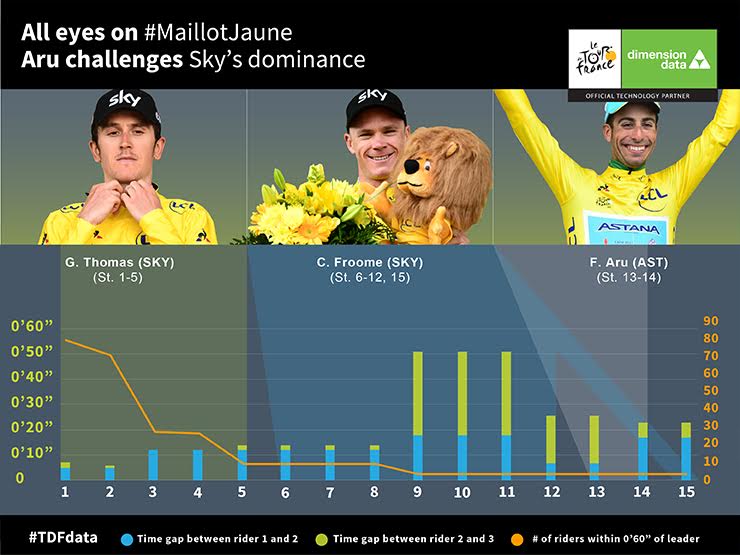DIGITAL SOLUTIONS
Highlights from Tour de France stages 10–15
The Tour de France tackled even more imposing mountains in the gruelling second week… and not without its fair share of drama. Let’s enjoy the view in data.
July 20, 2017

The Tour de France tackled even more imposing mountains in the gruelling second week… and not without its fair share of drama. Let’s enjoy the view in data.
After two weeks of intense racing, the 2017 Tour de France remains as thrilling as ever and the outcome is still anybody’s guess. Facing extreme slopes from the Jura to the Pyrenees, the peloton tackled many challenges. Yet, the General Classification remains extraordinarily tight with more and more riders trying to gain an edge on Sky’s dominance. Here are the data insights we’ve gathered to illuminate the crazy battle that’s sure to keep raging until Sunday.
A tight squeeze in the front
As always on the Tour, the Yellow Jersey is the most coveted prize. After years of barely challenged dominance by Team Sky, rivals are finally finding ways to shake Chris Froome’s (SKY) composure as Britain’s cycling powerhouse. At least temporarily so. Fabio Aru (AST) took the Yellow Jersey for two days so far. Once he’d established himself at the front, ‘Froomey’ – three times the ultimate winner of the Tour – had never lost the race leadership to anyone during a race before. He claimed it back from Aru (AST) at the end of stage 14, where four riders were within 29” of the leader. Across 103 previous races, such a small gap has never been seen this far into the Tour.

Challenges never seen before
There are fewer mountains on this year’s Tour, but more extreme slopes. The organisers really lay down the gauntlet for the 2017 peloton: many climbing sections have gradients of more than 15%. On the Col du Grand Colombier, the slope even rose to 22% … and it made a big difference. While Juraj Sagan (BOH) covered the section at 5.6km/h, the slowest average speed of the stage, South African climber Louis Meintjes (UAD) completed the climb at 10.2km/h – 83% faster! Sagan (BOH) was eventually left behind as one of the 12 riders who couldn’t complete the gruelling stage 9 within the time limit.

Short stages, big action
Another way for the Tour organisers to test the riders to the maximum is to throw short stages into the mix. Attackers come out of the woodwork on these brutal rides. The organisers took it a step further this July with stage 13’s 101km route packed with three climbs. There’s never been a shorter stage on the Tour in 45 years. Twice a Tour de France winner, Alberto Contador (TFS), grasped the opportunity to attack on the first climb of the day, and three of the best climbers in this year’s peloton followed close behind: Warren Barguil (SUN), Mikel Landa (SKY) and Nairo Quintana (MOV). It’s rare to see such high-profile riders attack so early. But was it a risky move? It paid off on the day: they made it to Foix well ahead of the pack.

Defining moments across the iconic Pyrenees
Before the shortest stage of the 2017 Tour, the Pyrenees offered the longest ride in the mountains: 214.5km from Pau to Peyragudes. The two days in the mountains delivered thrilling action, which was no surprise: the mountain range marks the border between France and Spain and has become one of the most iconic Tour de France landscapes in the past 114 years. Its beauty is both literally and figuratively breathtaking: 80.4km of categorised climbs in just two days this year, and all that an average gradient of 6.2%. The view from the top is always worth the effort, though. Just ask any winner of the Tour.

How data analytics creates real-time race predictions
Here’s how we use data in new and exciting ways to revolutionise your viewing experience this year. Read blog.
For live race updates, historical facts and stats, and rider profile data, follow @letourdata.